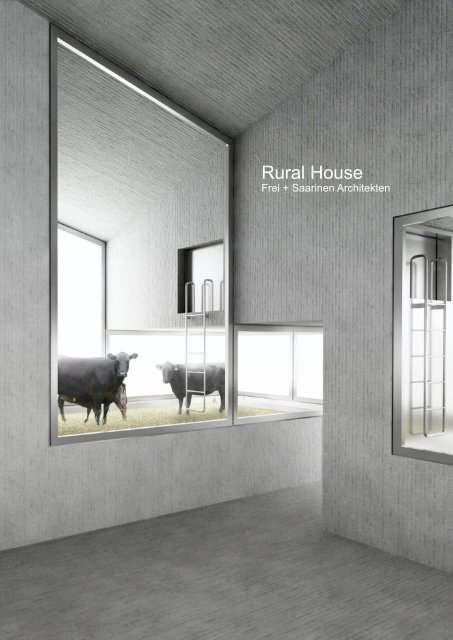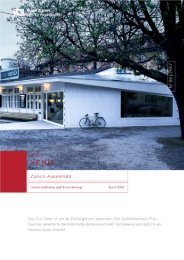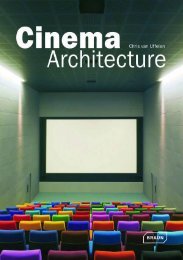Rural House - Frei + Saarinen
Rural House - Frei + Saarinen
Rural House - Frei + Saarinen
Create successful ePaper yourself
Turn your PDF publications into a flip-book with our unique Google optimized e-Paper software.
<strong>Rural</strong> <strong>House</strong><br />
<strong>Frei</strong> + <strong>Saarinen</strong> Architekten
Topic<br />
The given frame to propose a concept for a sustainable and affordable freestanding house in a rural area made us<br />
think about the rural condition in general and we wondered how an innovative concept for a rural house could look<br />
like.<br />
We discussed how a truly rural livestyle would influence architecture and we got interested in the idea of sharing<br />
the house with farm animals. This idea seems to correspond with the the need of human beings to run a farm. At<br />
least that‘s what we assume looking at the exploding amount of users playing Farmville, the most popular Facebook<br />
Application.<br />
Farming might be the only justification for covering untouched land. We were asked to make a design that fosters<br />
urban sprawl. But that might be okay under the condition that the surrounding land is used for food production.<br />
Being Swiss, we are familiar with cows. So we started to develope a 100m2-house that is combined with a cowstable<br />
plus some storage for hay, straw and forage. We discovered that there is not only an economic, atmospheric,<br />
spatial but also energetic potential in living close with animals: The bodywarmth of ten cows is sufficient to heaten<br />
all rooms.
Reference<br />
As an architectural reference we used not less than the most famous freestanding rural house on earth, Andrea<br />
Palladio‘s Villa Rotonda close to Vicenca, 1571.<br />
The architecture of the Rotonda is „virtual“ in the sense that it‘s completely without any correspondence to place or<br />
orientation as if it woult have been planned without knowing anything about the context. We speculated that Palladio<br />
might not have looked at the plot at all when he designed the building. By sharing the same problem of contextlessness<br />
with Palladio, we got more and more interested in his villa and his architecture in general.<br />
We started to like the rather weird idea of copying the concept of four entrances that are accessed by stairs. The<br />
square-shaped plan together with the redundance of accesses is ideal for a freestanding house that should work<br />
with no - or within every possible - context. Maybe Rotonda can also be read as archetypical design for a prefabricated<br />
house, because it‘s easy to implant it to almost every site. This might be one reason why Palladio‘s villa was<br />
copied and pasted to countless places all over the world.
Scheme<br />
It turned out that Rotonda‘s square-shape, the four accesses with four stairs, the high central hall, the access of the<br />
upper level by individual stairs and the pitched roof work perfectly for our purposes.<br />
upper level<br />
lower level
Use of space<br />
The usable area for humans is precisely 100m2. This „2-bedroom house“ that corresponds to the brief is intertwined<br />
with 4 stables with slightly different sizes plus room for hay, straw, forage.<br />
The inhabitants of the proposed house are not nescessarily farmers. We suggest a mix between house and stable<br />
- not house and farm, because that would be not realistic with the given size of the project. It‘s enough to have a<br />
farmer somewhere in the surroundings who would lend / rent the animals. Or maybe farmers would even pay for<br />
that new kind of outsourced stable.<br />
3 cows<br />
25m2<br />
3 cows<br />
49m2<br />
26m2<br />
3 cows<br />
2 cows<br />
for humans : 2 bedroooms 25m2 plus bath / shower room<br />
for cows: hay, straw, forage<br />
for humans: living room, kitchen, wardrobe<br />
for cows: 4 stables
Cow-appropriate spaces<br />
Looking at Damien Hirst‘s Golden Calf we were fascinated about the idea of placing the stables on a socle. The<br />
raised position of the calf makes it somehow look back. To be eye-in-eye with a cow, even if it‘s laying on the<br />
ground of the stable would be a more respectful way to watch cows and be whatched by cows.<br />
Cows are higly intelligent animals, The fact that cows that listen to music are more healthy and produce more milk<br />
proove that cows love to be entertained. This means that also cows benefit from the proposed idea of very close<br />
visual connections. We think that putting cows in an ordinary stables is a crime. The use of the inhabitants for the<br />
entertainment of the cows is not only funny, intellectually challenging, philosophically adventurous but also speciesappropriate<br />
Since the stables have to be on ground level, the living room is slightly sunken which dramatizes the experience<br />
of the surrounding landscape as comparative 3D-studys prooved. Additionally, the living room gets much more<br />
usable, because furniture like sofas, tables, sideboards etc. can be aranged along the walls without corrupting the<br />
spatial idea.<br />
We propose a humble socle, no marble. But we decided to copy Damien Hirst‘s way of how the glass is framed,<br />
because it has to be strong ( living cows instead of liquid-pressure ) and it seems to be formally convincing.
Spatial benefits<br />
The stables increase the total size of the house and make it more generous. The Rotonda-scheme with the high<br />
central hall allows visual connections through the hall or even from one facade to the other as shown above.<br />
The cows generate a foreground for the visual experience of the landscape. This foreground-condition leads to two<br />
effects: Firstly, a hypercloseness to nature is generated. A cow is impressing - not only because its beauty but also<br />
for its sheer size. Secondly, the stable acts as a buffer, not only in the energetic sense but also aesthetically: Like<br />
the Villa Rotonda, the proposed rural house should work in every possible context. If the view to the surroundings is<br />
problematic there are still beautiful creatures in the foreground.
How the stables work<br />
The cow feces are collected in the socle area below the perforated stablefloor. The storage room for hay, straw and<br />
forage is directly connected to each stable. Delivery to the storage is possible from outside.
Sustainability and energetical benefits<br />
Gas from the feces is used for cooking and water heating. The bodywarmth of ten cows is sufficient to heaten all<br />
rooms. Additional heating is not nescessary.<br />
Affordability<br />
The simplicity of the architecture in terms of structure, volumetry, use of materials and detailing leads to an affordable<br />
result. The cows generate heat and gas for free and might even generate an income if the outsoursced<br />
stable-space is paid by a farmer who sells milk and meat.
Preliminary sketch<br />
<strong>Frei</strong> + <strong>Saarinen</strong> Architekten, Zurich<br />
Barbara <strong>Frei</strong>, Martin <strong>Saarinen</strong>, Stefan Wülser<br />
www.freisaarinen.ch






